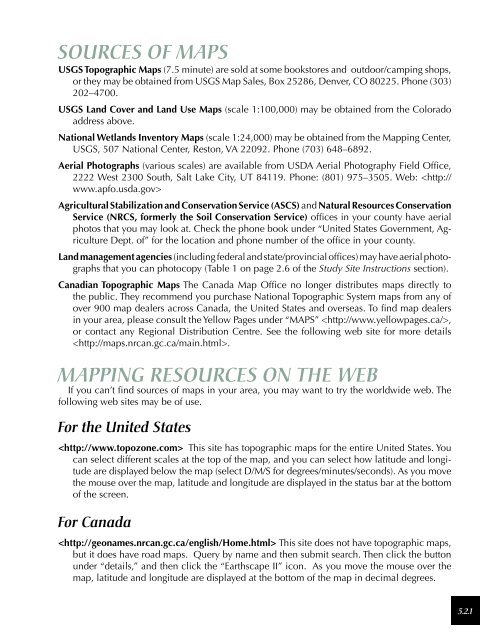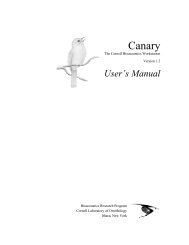SOURCES OF MAPS MAPPING RESOURCES ON THE WEB
SOURCES OF MAPS MAPPING RESOURCES ON THE WEB
SOURCES OF MAPS MAPPING RESOURCES ON THE WEB
Create successful ePaper yourself
Turn your PDF publications into a flip-book with our unique Google optimized e-Paper software.
<strong>SOURCES</strong> <strong>OF</strong> <strong>MAPS</strong><br />
USGS Topographic Maps (7.5 minute) are sold at some bookstores and outdoor/camping shops,<br />
or they may be obtained from USGS Map Sales, Box 25286, Denver, CO 80225. Phone (303)<br />
202–4700.<br />
USGS Land Cover and Land Use Maps (scale 1:100,000) may be obtained from the Colorado<br />
address above.<br />
National Wetlands Inventory Maps (scale 1:24,000) may be obtained from the Mapping Center,<br />
USGS, 507 National Center, Reston, VA 22092. Phone (703) 648–6892.<br />
Aerial Photographs (various scales) are available from USDA Aerial Photography Field Office,<br />
2222 West 2300 South, Salt Lake City, UT 84119. Phone: (801) 975–3505. Web: <br />
Agricultural Stabilization and Conservation Service (ASCS) and Natural Resources Conservation<br />
Service (NRCS, formerly the Soil Conservation Service) offices in your county have aerial<br />
photos that you may look at. Check the phone book under “United States Government, Agriculture<br />
Dept. of” for the location and phone number of the office in your county.<br />
Land management agencies (including federal and state/provincial offices) may have aerial photographs<br />
that you can photocopy (Table 1 on page 2.6 of the Study Site Instructions section).<br />
Canadian Topographic Maps The Canada Map Office no longer distributes maps directly to<br />
the public. They recommend you purchase National Topographic System maps from any of<br />
over 900 map dealers across Canada, the United States and overseas. To find map dealers<br />
in your area, please consult the Yellow Pages under “<strong>MAPS</strong>” ,<br />
or contact any Regional Distribution Centre. See the following web site for more details<br />
.<br />
<strong>MAPPING</strong> RE<strong>SOURCES</strong> <strong>ON</strong> <strong>THE</strong> <strong>WEB</strong><br />
If you can’t find sources of maps in your area, you may want to try the worldwide web. The<br />
following web sites may be of use.<br />
For the United States<br />
This site has topographic maps for the entire United States. You<br />
can select different scales at the top of the map, and you can select how latitude and longitude<br />
are displayed below the map (select D/M/S for degrees/minutes/seconds). As you move<br />
the mouse over the map, latitude and longitude are displayed in the status bar at the bottom<br />
of the screen.<br />
For Canada<br />
This site does not have topographic maps,<br />
but it does have road maps. Query by name and then submit search. Then click the button<br />
under “details,” and then click the “Earthscape II” icon. As you move the mouse over the<br />
map, latitude and longitude are displayed at the bottom of the map in decimal degrees.<br />
5.2.1
HOW TO DETERMINE<br />
LATITUDE AND L<strong>ON</strong>GITUDE<br />
L<br />
atitude and longitude are measured using degrees (°), minutes (‘), and seconds (“). Each degree<br />
of latitude or longitude contains 60 minutes, and each minute contains 60 seconds. These<br />
instructions explain how to determine latitude and longitude from a 7.5-minute USGS topographic<br />
map. You can use the same basic procedure on any other map that has latitude and<br />
longitude markings.<br />
A 7.5-minute map covers a range of 7.5 minutes (7‘30”) of latitude and 7.5 minutes (7‘30”) of<br />
longitude. Lower values of latitude are toward the bottom of the map, lower values of longitude<br />
are toward the right. You will notice that each corner of the map is marked with a latitude and<br />
longitude. For example, let’s assume that the lower right corner is marked 42°00‘ and 86°15‘.<br />
This means that any point on the map has a latitude that is between 42°00‘ and 42°07‘30” and<br />
a longitude that is between 86°15‘ and 86°22‘30”.<br />
Usually the degrees are only indicated on the corners of the map. You will notice however,<br />
that there are small marks every 2‘30” along the edge of the map. If you own the map, you might<br />
want to use a ruler to draw lines across the map that connect the matching marks. This will break<br />
your map into nine small blocks, each with a range of 2‘30” on each side. Now you just need to<br />
estimate or calculate the actual latitude and longitude for a point inside one of these blocks.<br />
Using our same example, the lower right block now covers latitudes between 42°00‘ and<br />
42°02‘30” and longitudes between 86°15‘ and 86°17‘30”. If your study point was in the middle<br />
of this section the latitude would be 42°01‘15” and the longitude would be 86°16‘15”.<br />
For more accurate estimates, you might want to draw a grid on the appropriate section of<br />
your map. Again using the same example, if you carefully break down the lower right section<br />
into five equal sections in each direction, the resulting rectangles will be only 30” on each side.<br />
This should now make it fairly easy to estimate the actual latitude and longitude within 5 to 10<br />
seconds.<br />
Contact a site coordinator or the BFL staff if you have any questions.<br />
5.2.2
















